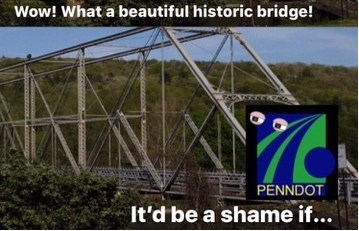Gas Migration into the Susquehanna River and Surrounding Area . . .
November 15, 2011Fracking and Quaking: They're Linked
November 18, 2011Amwell Township is a 44-square-mile plot of steep ravines and grassy pasturelands planted with alfalfa, trefoil and timothy in the southwestern corner of Pennsylvania. It’s home to some 4,000 people, most of whom live in villages named Amity, Lone Pine and Prosperity. continue reading article…
More investigations from the NY Times . . .
Nov 25
NY Times: Millions Spent in Albany Fight to Drill for Gas As Hydrofracking Decision Nears, Industry Spending Skyrockets
By THOMAS KAPLAN
http://www.nytimes.com/2011/11/26/nyregion/hydrofracking-debate-spurs-huge-spending-by-industry.html?_r=2&hp
Nov 30
“Testimony was dominated by passionate opponents who called for a state ban on fracking…”
NY Times green blog on DEC hearing
http://green.blogs.nytimes.com/2011/11/30/chants-boos-and-celebrities-at-a-standoff-on-fracking/?scp=1&sq=dec%20hearing&st=cse
Dec 2
Another investigative article by Ian Urbina (and Jo Craven McGinty).
Learning Too Late of Perils in Gas Well Leases
http://www.nytimes.com/2011/12/02/us/drilling-down-fighting-over-oil-and-gas-well-leases.html
The Fracturing of Pennsylvania continued
From some views, this diamond-shaped cut of land looks like the hardscrabble farmland it has been since the 18th century, when English and Scottish settlers successfully drove away the members of a Native American village called Annawanna, or “the path of the water.” Arrowheads still line the streambeds. Hickory trees march out along its high, dry ridges. Box elders ring the lower, wetter gullies. The air smells of sweet grass. Cows moo. Horses whinny.
From other vantages, it looks like an American natural-gas field, home to 10 gas wells, a compressor station — which feeds fresh gas into pipelines leading to homes hundreds of miles away — and what was, until late this summer, an open five-acre water-impoundment chemical pond. Trucks rev engines over fresh earth. Backhoes grind stubborn stones. Pipeline snakes beneath clear-cut hillsides.
The township sits atop the Marcellus Shale Deposit, one of the largest fields of natural gas in the world, a formation that stretches beneath 575 miles of West Virginia, Pennsylvania, Ohio and New York. Shale gas, even its fiercest critics concede, presents an opportunity for the United States to be less dependent on foreign oil. According to Wood Mackenzie, an energy-consulting firm, the Marcellus formation will supply 6 percent of America’s gas this year, a figure expected to more than double by 2020.

Haney’s children have shown signs of exposure to arsenic, and
some of their animals got sick or died.
When the natural-gas industry came to town, Haney saw an opportunity to pay off farm bills and make a profit from the land. Word had it that the companies were interested in signing up large parcels, so in the winter of 2008, Haney, who owned only eight acres, persuaded two of her neighbors to pool their land on a lease for which she was paid, in installments, $1,000 dollars per acre and 15 percent royalties.
The money would help to pay the taxes on their farms. The land man who came to the Haney home to sell the lease showed pictures of a farm and pasture with a well cap “the size of a garbage can,” Haney said, which she found reassuring. And it didn’t seem as if the drilling would affect their lives much. Range Resources was involved in the community in small ways too. For the past several years, it operated a booth at the Washington County Fair. In 2010, the company offered kids an extra $100 for the farm animals they auctioned. That was the year Stacey Haney’s son, Harley, took his breeding goat, Boots, all the way to grand champion.
At the fair, Haney ran into her next-door neighbor, Beth Voyles, 54, a horse trainer and dog breeder, who signed the lease with Haney in 2008. She told Haney that her 11 /2-year-old boxer, Cummins, had just died. Voyles thought that he was poisoned. She saw the dog drinking repeatedly from a puddle of road runoff, and she thought that the water the gas company used to wet down the roads probably had antifreeze in it. “We do not use ethylene glycol in the fracking process,” Matt Pitzarella of Range Resources told me. He also said that the dog’s veterinarian couldn’t confirm the dog had been poisoned and that another possible cause of death was cancer.
A month later, Haney’s dog, Hunter, also died suddenly. Soon after, Voyles called Haney to tell her that her barrel horse, Jody, was dead. Lab results revealed a high level of toxicity in her liver. Voyles sent her animals’ test results to Range Resources. In response, Range Resources wrote to Voyles to say that, as the veterinarian indicated, the horse died of toxicity of the liver, not antifreeze poisoning. The company did acknowledge that the vet suspected the horse died of poisoning by heavy metals. Subsequent tests of the Voyleses’ water supply by Range Resources revealed no heavy metals.
Voyles’s boxers began to abort litters of puppies; six were born with cleft palates. They died within hours. Others were born dead or without legs or hair. Unsure what to do, Voyles stored 15 of the puppies in her freezer. (Range Resources says it was never notified about the puppies.) By December, Boots, the grand-champion goat, aborted two babies. Haney had to put her down the day after Christmas.
What was going on with the animals? Where were the toxic chemicals in their blood coming from? Haney feared that the arrival of the gas industry and the drilling that had begun less than 1,000 feet from her home might have something to do with it.
Registering needed, but no charge.



